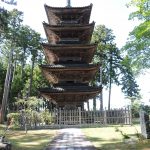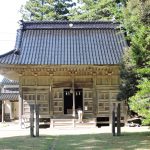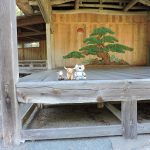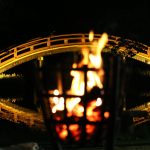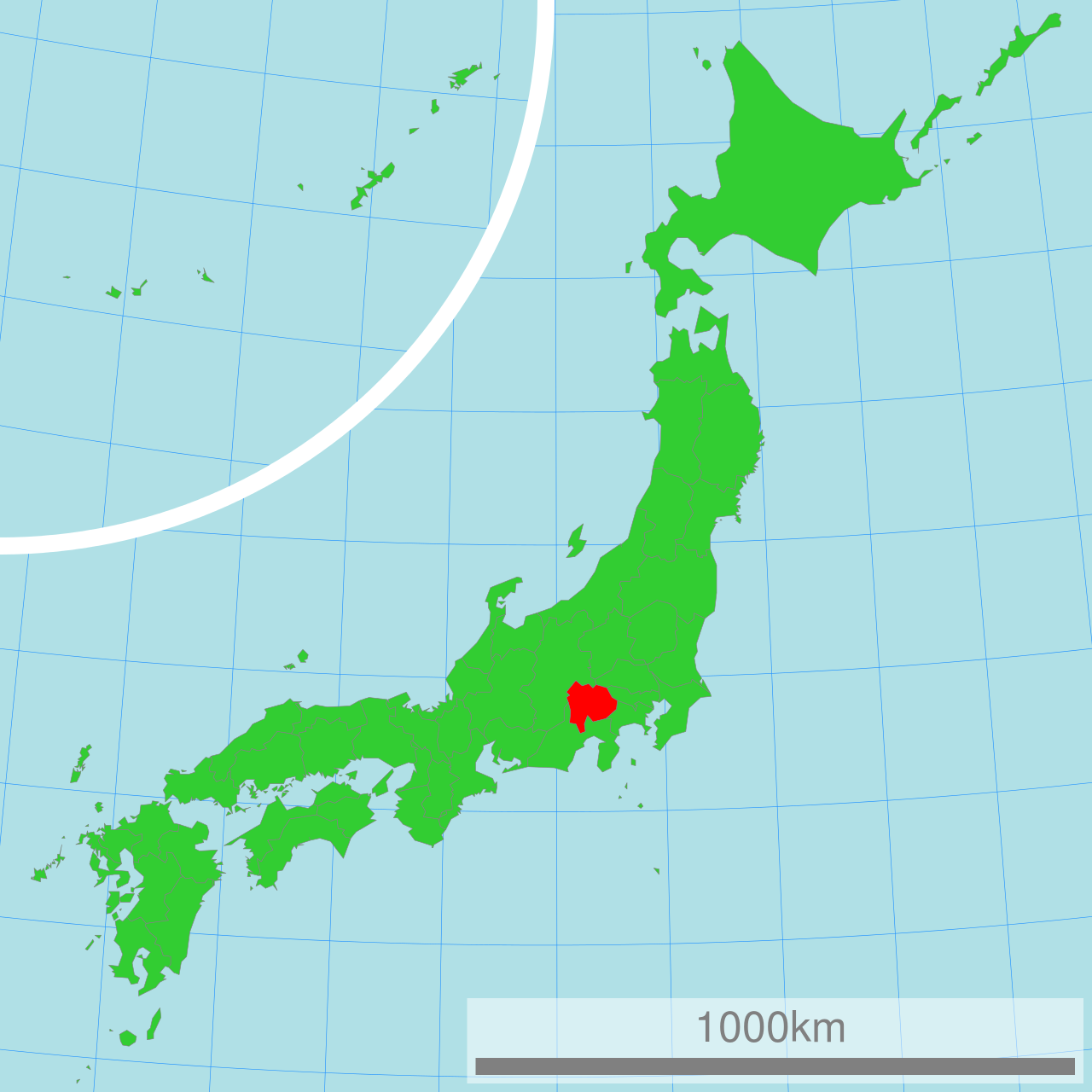和文は英文の下にございます。/The Japanese translation is below the English text.
Myosenji Temple and Daizen Shrine, Sado
Table of contents 1. The sixth largest island 2. Temples and Shrines 3. Myosenji Temple 4. Daizen Jinja Shrine 5. Noh Stages
1. The Sixth largest island
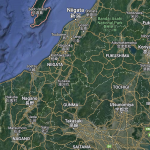
Sado Island (Sado-ga-shima, a.k.a. Sado-shima) is an interesting travel destination.
Japan is an archipelago and the largest islands in the country are called Honshu, Hokkaido, Kyushu, and Shikoku. The residents of the rest of the islands call the big four “the mainland”.
Of “the rest”, the largest is the main island of Okinawa, Okinawa Prefecture, and the second largest is Sado Island, Niigata Prefecture.
Sado Island has a shape like the character “エ (eh)”, of which the northern part has mountains, while the southern part has hills formed almost parallel to the mountains.
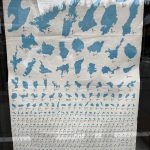
Between them is a cultivated plain. On the coast, people have developed terraced towns and fields of rice, vegetables, and orchards. The views of nature and cultivated land are both beautiful.
On the opposite side of the strait, the rest of Niigata on the mainland is known for heavy snowfalls, but on Sado Island it does not snow much. The temperature doesn’t often go below freezing either. They owe the mild climate to the warm sea current from the south, and so they can grow any kind of fruit produced anywhere in Japan.
Maybe because of the mild climate, Sado has been inhabited since ancient times. Even “Kojiki (712 A.D.)” and “Nihon-Shoki (720 A.D.)”, the oldest books compiled in Japan, mention it as one official province of the then young country.
Today, Sado Island is a popular destination for those interested in sightseeing, hiking, alpine plants, geology, sports, Japanese history and culture.
Boats and flights connect it to the mainland. For example, it takes about an hour by jetfoil, a super-rapid boat, from Niigata Port to Ryotsu Port on Sado. Shinkansen takes you to Niigata from Tokyo in about two hours, so some even plan a day trip from Tokyo area.
2. Temples and Shrines
The current population of Sado is less than fifty thousand, but there are more than 250 Buddhist temples on the island. A temple is often standing in the vicinity of a Shinto shrine as if they were close friends.
It is because in Sado, temples and shrines have specific roles to play in people’s lives: Temples hold funeral and memorial services, and maintain the graveyard. Shrines practice rites to pray for happiness and good luck for people and good economy for businesses. Shrines also celebrate various festivals, and they are the starting point for the procession of the famous “ondeko” drums to visit people’s homes to fend off evils.
We visited one of those pairs: Myosenji (Myosin Temple) and Daizen Jinja (Daizen Shrine).
3. Myosenji Temple
Myosenji Temple was opened in 1278.
Nichiren, one of Japan’s most influential priests, was banished to Sado in 1271. A local called Tametomo ENDO was assigned to take care of him in banishment. As Tametomo lived with Nichiren, he was so impressed that he and his wife both converted to Buddhism. They even turned their residence into a temple, which was the origin of this temple.
Located on its grounds is the grave of Suketomo HINO.
Suketomo was an aristocrat who served Emperor Godaigo in the early 14th Century. He and other followers of Godaigo were suspected of taking part in a plot to overthrow the Kamakura government and in 1324 he was banished to Sado. He died eight years later.
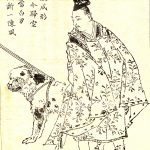
[Source: public domain, https://commons.wiki
media.
org/w/index.php?curid=1144201]
Some records describe Suketomo’s character. He was so smart and well-versed in Song-period neo-Confucianism that he became a close aid to Emperor Godaigo. Also, he was outspoken and blunt; he would say bad things about such people as revered old priests and handicapped homeless people.
Myosenji Temple is also famous for its five-tier tower, the only one in Niigata Prefecture. You often see beautiful five-tier towers in Kansai region, but not in Hokuriku and Tohoku regions. Two generations of carpenters directed the construction for 90 years and completed it in 1825. It is amazing that it is still standing after almost two hundred years in a country frequented by earthquakes.
4. Daizen Jinja Shrine
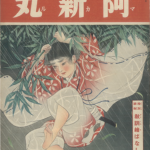
Suketomo NIHO mentioned earlier had a son named Kumawaka-maru. When he was twelve years old, Kumawaka-maru, against his mother’s opposition, bravely pushed through and traveled alone from Kyoto to Sado to meet his banished father. However, Suketomo had been executed by the time he arrived.
Kumawaka-maru considered the acting military governor who made the decision of the execution and the executioner to be his father’s murderers and enemies. He attacked them on a stormy night, managed to kill the executioner and ran away. Later he served a couple of Emperors in the Southern court.
After the Meiji Restoration (1867), Kumawaka-maru’s adventures were a favorite subject in moral class in elementary schools for his loyalty to the emperors and his devotion to his father.
Right after Kumawaka-maru avenged his father’s death, he was desperately looking for a way to shake off his pursuers. A Buddhist priest named Daizen-bo sympathized with his situation and helped him escape from Sado. Later, the Kamakura government executed the priest for this action.
Several years later, the government raised a fund to build a shrine to appease the spirit of Daizen-bo, and they named the shrine after him. They also enshrined Suketomo HINO here.
An aristocratic son took his father’s revenge at age twelve (in the preceding Heian Era, aristocrats hated to see blood, let along shedding it). The priest had such courage that he helped another at the risk of his own life. The government ruthlessly executed a monk who had abandoned the world. Kamakura era (1192-1333) was a wild time.
5. Noh Stages
Daizen Jinja Shrine is also famous for its Noh theater stage.
Noh is a classical Japanese opera, consisting of acting, dance, singing, and instrumental music. In Noh, performers speak and sing in old language, and so we need to read the story in advance.
There are about thirty Noh stages on Sado, and the one at Daizen Jinja is the oldest active one. This is also the only stage bare to the elements, so you can see the scene panel from the yard.
From the Middle Ages, Noh was considered to be the cultural refinement of the samurai class. Therefore, in the late Edo era, samurais used the old Noh language to discuss the future of Japan with their counterparts in other provinces.
However, in Sado, commoners such as peasants enjoyed Noh. At one point, there were as many as two hundred Noh stages there. A “haiku” tells us the surprise of a poet who travelled there in around 1914:
Uguisu ya jukko no mura nimo Noh-butai (It is spring; a warbler is singing. Even in a hamlet of only ten houses, there is a Noh stage!)
-Omachi Keigetsu
The story behind this is: In 1603, when the Tokugawas established the shogunate, the new magistrate from Edo brought a Noh performer to Sado. The magistrate dedicated Noh performances at various shrines across Sado, allowing commoners to see and enjoy them. One of them loved it so much that he went to Edo to learn Noh. Eventually he returned and spread it among the people of Sado.
Today, Sado is the place in Japan where they perform Noh most often. There are fewer performers, but they still play various pieces every year from spring to fall. Sado’s style is the dreamy “Takigi Noh”; they perform only at night by the fire of torches.
Please continue reading: => A Trip to Yahiko Shine
[End of English post]
大膳神社と妙宣寺
目次 1. 六番目に大きな島 2. お寺と神社 3. 妙宣寺 4. 大膳神社 5. 能舞台
1. 六番目に大きな島
この投稿では、佐渡ヶ島(佐渡島、佐渡ともいいます)の観光情報を少しお話ししたいと思います。
日本は島国で、そのうち一番大きな本州、北海道、九州、四国の四つは、他の島の住民からは「本土」と呼ばれます。
その「他の島」の中で一番大きいのは沖縄県の沖縄本島。二番目が、新潟県の佐渡ヶ島なのです。
佐渡ヶ島はカタカナの「エ」のような形で、北に大佐渡山地、南に小佐渡丘陵が並行しています。その間の平野、沿岸の段丘に人が住んだり田畑を作ったり、自然と人の営みの様子が美しい。
新潟県の本土がわは豪雪で知られますが、佐渡ヶ島では雪はあまり降りません。気温が零下になることもあまりないそうです。これは対馬海流という暖流のおかげで、日本でできる果物はどの種類でも佐渡で育つということでした。
住みやすい気候のせいか、佐渡には大昔から人が住んでいました。日本で一番古い書物、古事記 (712年) と日本書紀 (720年) にも一つのくにとして出ているくらいです。
現代でも、観光、ハイキング、高山植物、地学、スポーツ、歴史や文化などに興味のある人にはとてもおもしろい旅行先です。
本土からの連絡は、船や飛行機があります。例えば本土の新潟港から佐渡の両津港まで、ジェットフォイルなら約1時間で着きます。東京から新潟まで新幹線で2時間ぐらいなので、東京から日帰りも可能です。
2. お寺と神社
佐渡ヶ島の人口は5万人ぐらいですが、お寺は今でも250以上あります。そして、佐渡では仏教のお寺と神道の神社が仲良く並んで建っていることがよくあります。
なぜかというと、この二つは佐渡の人々の暮らしと密接に関わっていて、お寺はお葬式をしてくれるところ。神社は、お祭りや鬼太鼓などを通じて、幸運や商売繁盛を祈願してくれる場所になっているからです。
そんなお寺と神社のひと組を訪れました。妙宣寺と大膳神社です。
3. 妙宣寺
妙宣寺は、1278年ごろ開かれたお寺です。
日蓮という高僧が1271に佐渡に配流になったとき、遠藤為朝という人が日蓮に仕えました。為朝は一緒に暮らすうちに日蓮の影響を受け、妻と共に出家しました。この時、自分の住まいを修行道場にしたのがこのお寺の始まりです。
このお寺には、日野資朝という公家のお墓があります。
日野資朝は14世紀の初めごろ後醍醐天皇の側近でした。後醍醐天皇に従う人々と主に、後醍醐の幕府への謀反計画加担を疑われ、1324年に佐渡に流されたのです。8年後に佐渡で生涯を終えました。
資朝の人となりについて少し記録が残っています。宋の思想に詳しく学のある人で天皇の側近となった一方、お年寄りや体の不自由な人に失礼で思いやりのないこともずけずけいう人だったようです。
妙宣寺はまた、新潟県で唯一の五重塔(重要文化財)があることでも有名です。五重塔は関西には多いけれど、北陸や東北地方には少ないのです。1825年の建立ですが、親子二代の宮大工が90年かけて完成した五重塔は、地震の多い国で、よく200年近く建っていると思います。
4. 大膳神社
さて、前述の日野資朝には阿新丸という息子がいました。阿新丸は流罪になった父に会いたくて、12歳の時母の反対を押し切って、一人で京都から佐渡に渡ってきました。しかし、資朝は阿新丸が着く少し前に処刑されていました。
阿新丸は処刑した役人を「親のかたき」として殺して逃亡、その後も南朝方の天皇を補佐して活躍しました。阿新丸の冒険は忠(天皇に尽くしたこと)・孝(親の敵を殺したこと)の鑑として、戦前の日本の小学校では有名な物語だったといいます。
さて、阿新丸が佐渡を脱出する時、大膳坊という僧があわれんで助けてやりました。大膳坊は後に、このかどで、幕府によって処刑されました。
数年後、幕府側は大膳坊の霊を慰めるために神社を勧進し、この神社を大膳神社と名づけました。ここには日野資朝も併せて祀られています。
平安時代までは血を流すのを忌んだ公家の息子がわずか12歳で敵討をする。命を顧みず少年を助けた勇気ある僧がいる。幕府は人外の存在である僧をあっさり処刑する。鎌倉時代 (1192-1333) は人の心が荒々しい時代だったと思います。
5. 能舞台
大膳神社は、能舞台があることでも有名です。
能は日本の伝統的なオペラのようなもので、演技と舞い、うた、楽器で演じます。昔の言葉で語ったりうたったりするので、ストーリーを最初に読んでおきます。
能舞台は佐渡には30ほどありますが、大膳神社の能舞台は現在でも公演が行われる最古のものです。また、これだけは吹きさらし状態の舞台で、庭から鏡板がそのまま見えます。
能は中世から武士階級の教養とされます。江戸後期に武士階級の人が他国の武士と日本の将来を語り合う時、お互い方言で通じない時は能言葉で意思疎通したと言われます。
それが、佐渡では珍しく百姓などの庶民が能を楽しんでいました。1914年ごろ佐渡を旅したある歌人は驚いて、こんな歌を詠みました。
鶯や十戸の村の能舞台(春、鶯の声が聞こえるのどかな田舎で、家がたった十軒しかない小さな村にも能舞台があるよ!)
大町桂月
これには、興味深い背景があります。
江戸幕府が成立した1603年、新しい佐渡代官が江戸から赴任してきました。この代官は能楽師を同行させていて、在任中、佐渡の各地の神社で能を奉納しました。庶民も能を見ることが許されました。能を見て深く感銘を受けた人が江戸へ能を学びにいき、帰ってから佐渡に広めたと言われています。
今、佐渡では現代の日本では最も能が盛んな場所です。舞手は減っていますが、毎年春から秋にかけてあちこちで演じられています。佐渡の能は、夜にたいまつのあかりで演じる夢幻的なもので、薪能といいます。
[和文部終わり]

